Italian Sourdough Starter – Lievito Madre Recipe
Italian Sourdough Starter – Lievito Madre Recipe is made a little bit different then the more well known version. This is a lower hydration starter which also takes longer to produce. But it is well worth it.

So after making a Sourdough Starter that most of us usually use, I decided that I wanted to also give the Italian version, Lievito Madre a try. A friend explained how it is made and here is the result. Time is needed but it is very easy and straight forward.
How to make it
Step 1
In a small bowl mix together the lukewarm water and honey, then add the flour and make a non sticky dough ball

Mark with a cross. Then place in a large glass jar, place lid on top but do not close. Let sit in a warm draft free area for 48 hours.

Step 2
Remove 100 grams of the dough, it’s best to remove the top part of the dough which tends to be dry, then keep 100 grams of the remaining dough (discard anything over the 100 grams), place in a bowl and add the flour and water, knead to form a compact dough, make a cross. Place in the jar (which has been cleaned, rinsed well and dried). Cover lightly and let rest again for 48 hours.
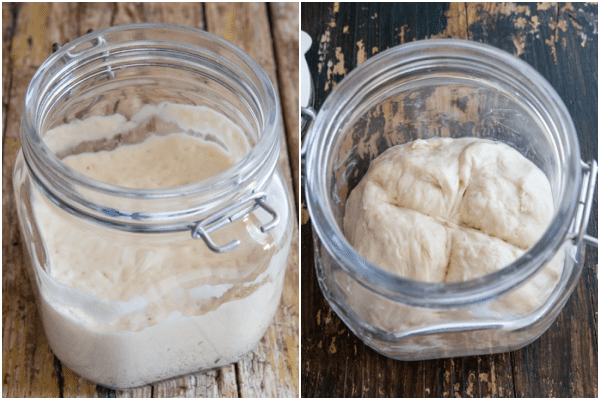
Step 3
Remove 100 grams of the dough, it’s best to remove the top part of the dough which tends to be dry, then keep 100 grams of the remaining dough (discard anything over the 100 grams), place in a bowl and add the flour and water, knead to form a compact dough, make a cross. Place in the jar (which has been cleaned, rinsed well and dried). Cover lightly and let rest again for 48 hours.

Step 4
Remove 100 grams of the dough, it’s best to remove the top part of the dough which tends to be dry, then keep 100 grams of the remaining dough (discard anything over the 100 grams), place in a bowl and add the flour and water, knead to form a compact dough, make a cross. Place in the jar (which has been cleaned, rinsed well and dried). Cover lightly and let rest again for 48 hours.
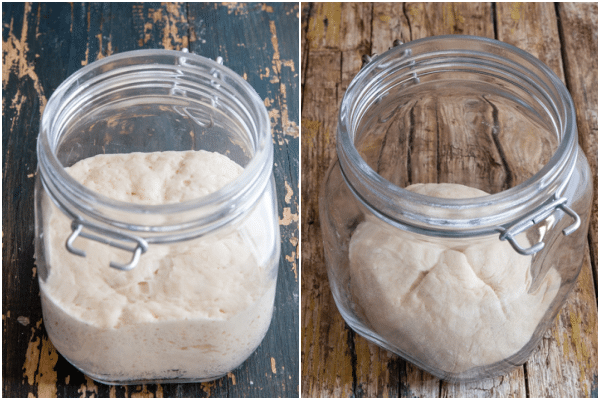
Step 5
Remove 100 grams of the dough, it’s best to remove the top part of the dough which tends to be dry, then keep 100 grams of the remaining dough (discard anything over the 100 grams), place in a bowl and add the flour and water, knead to form a compact dough, make a cross. Place in the jar (which has been cleaned, rinsed well and dried). Cover lightly and let rest again for 24 hours.
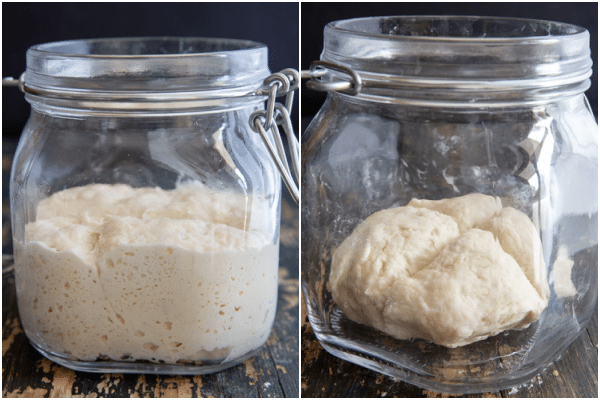
Step 6
Again remove 100 grams of the dough, it’s best to remove the top dry part of the dough, then keep 100 grams of the remaining dough (discard anything over the 100 grams), place in a bowl and add the flour and water, knead to form a compact dough, make a cross. Place in the jar (which has been cleaned, rinsed well and dried). Cover lightly and let rest again for 24 hours.
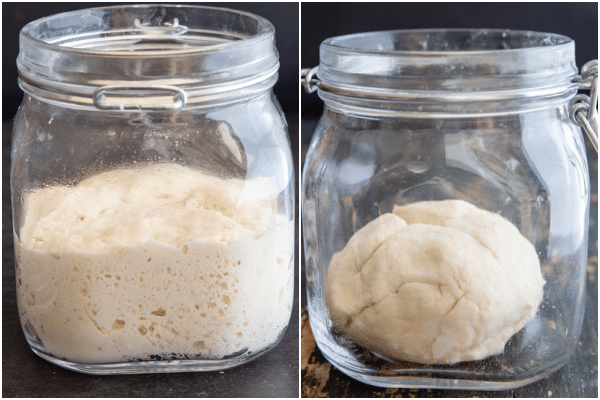
Step 7
Again remove 100 grams of the dough, it’s best to remove the top dry part of the dough, then keep 100 grams of the remaining dough (discard anything over the 100 grams), place in a bowl and add the flour and water, knead to form a compact dough, make a cross. Place in the jar (which has been cleaned, rinsed well and dried). Cover lightly and let rest again for 24 hours.
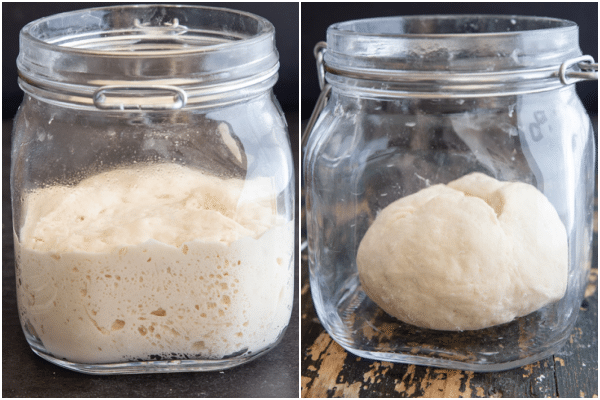
Step 8
Again remove 100 grams of the dough, it’s best to remove the top dry part of the dough, then keep 100 grams of the remaining dough (discard anything over the 100 grams), place in a bowl and add the flour and water, knead to form a compact dough, make a cross. Place in the jar (which has been cleaned, rinsed well and dried). Cover lightly and let rest again for 24 hours.
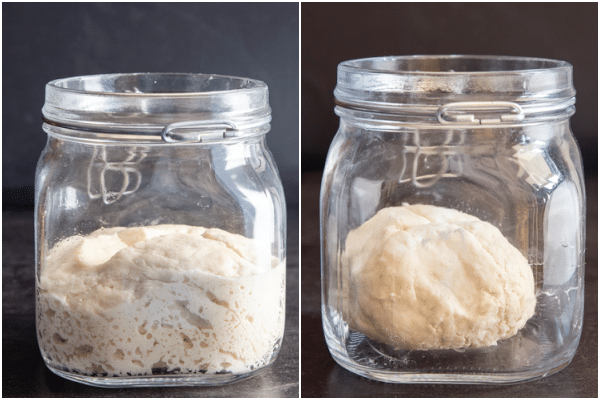
Step 9
Again remove 100 grams of the dough, it’s best to remove the top part of the dough, then keep 100 grams of the remaining dough (discard anything over the 100 grams), (from today on discard can be used for baking), place in a bowl and add the flour and water, knead to form a compact dough, make a cross. Place in the jar (which has been cleaned, rinsed well and dried). Cover lightly and let rest again for 24 hours.
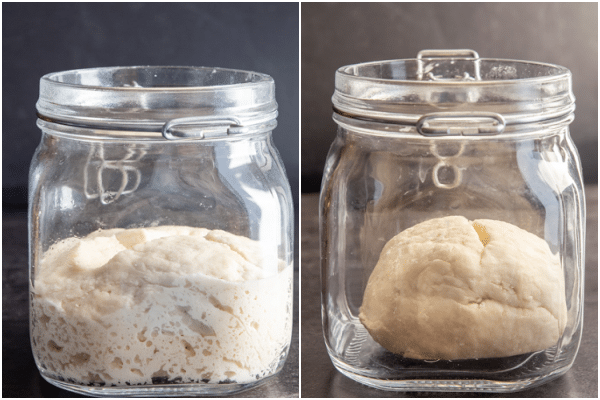
Step 10
Again remove 100 grams of the dough, it’s best to remove the top dry part of the dough, then keep 100 grams of the remaining dough (discard anything over the 100 grams), place in a bowl and add the flour and water, knead to form a compact dough, make a cross. Place in the jar (which has been cleaned, rinsed well and dried). Cover lightly and let rest again for 24 hours.
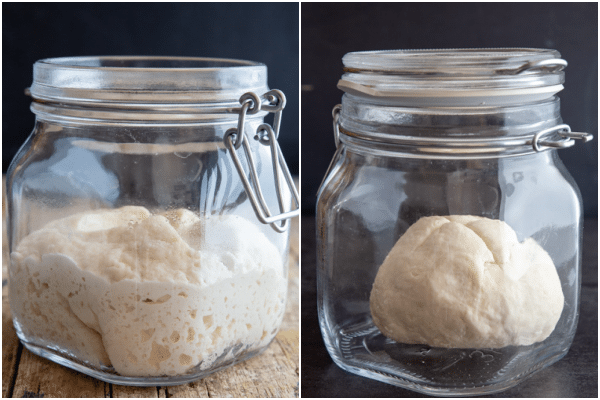
Step 11
Again remove 100 grams of the dough, it’s best to remove the top dry part of the dough, then keep 100 grams of the remaining dough (discard anything over the 100 grams), place in a bowl and add the flour and water, knead to form a compact dough, make a cross. Place in the jar (which has been cleaned, rinsed well and dried). Cover lightly and let rest again for 24 hours.

Step 12
Ready to use!

The few days you probably won’t notice much difference in growth but the yeast will be stronger.
What is the best jar to use?
The best jar to use is a glass jar with a lid, it’s best to have one that is large enough that you can stick your hand in.
Why is a Natural Starter a better choice?
A natural starter or sourdough starter gives a more intense flavour to your bread recipe. You will also have a better developed crumb, which helps the bread to grow in height rather than width. It also has a better shelf life, this is because of the level of acidity of the dough which tends to inhibit most of the moulds, it also keeps its aroma for a longer period and has a more appealing crust colour.
Some people find (me included) that it is easier to digest because of the the transformation of the more complex substances into simpler ones, therefore it makes it easier for our bodies to absorb.
What equipment do you need?
To get everything set up to start, you are going to need, a good quality all purpose or bread flour (unbleached), chlorine free water (bottled or filtered), a scale – because I think working in grams is best for bread, a thermometer, a large jar with a lid.
Why make a cross in the dough?
The cross, according to popular superstition, was used to bless the dough of bread and to drive out demons or evil forces that would have hindered the leavening. In fact, it is said that having received from the Pope, the order to bless the loaves, Saint Clare made the sign of the cross on them. So a little Italian superstition never hurt!
What is the best room temperature for the starter?
The starter should be kept in a warmish room, the best temperature would be anywhere from 70-85F (21-30C).
What are some of the differences between the two starters?
- Lievito Madre is a much firmer starter, more like a dough.
- There will be no liquid (hooch) produced this way.
- I find the aroma is not as strong.
Why is the starter dough discarded?
The starter is discarded so that there is less flour needed to maintain it. If you just added the same amount of flour each time you refresh the stater (without removing any starter), you would eventually come to a point where the added flour is not enough to refresh the starter and it would starve.
The starter is not a real starter until you have arrived at about step 9 or 10 and sometimes longer. It takes time for the organism balance to get established.
What to make with discarded starter
Lots of people, me included would rather not throw away food, (but unfortunately you will have to eliminate some of that starter at the beginning), and that goes for discarded starter, here are a few ideas that you can use with it. A fast and simple one is frying it, sprinkle with your favourite spices and fry in some oil. You could share it with friends once it is developed.
I started to use the discard after day 10, or you could refrigerate it and keep adding the discard until you have enough for a recipe (recipes to follow). It will last up to 2-3 months in the fridge.
What to do when the starter is active
Once the starter is active the first thing to do is give it a name, yes people name their starters. Then you can refrigerate the starter especially if you plan on baking bread about once a week. If you plan on baking everyday then the starter should be kept on the counter. And fed once a day.
How to store the Lievito Madre
Store it in a clean glass or another container that is suitable for food, it should be at least three times larger than the starter. Do not close it tightly, leave it in the refrigerator until the next use, remember to refresh it every 5-7 days at the most if not using.
How to refresh the starter
Remove the starter from the refrigerator and leave it at room temperature for an hour , if your house is cooler then extend the time to about 2 hours. Eliminate the top layer of the dough, which may be dry and crusty. Remove 100 grams, add 50 grams of water and 105 grams of flour. knead the dough until you get a compact dough.
Engrave a cross on the dough and place it in the clean glass jar. Let it sit at room temperature until it has doubled (3-4 hours) then place it back in the fridge.
How to bake with a refrigerated starter
When you want to use the starter, it must be refreshed, a part will then be used and a part will be kept in the refrigerator for subsequent uses. To refresh the starter for use, proceed in this way.
Remove the starter from the refrigerator and leave it at room temperature for an hour or two (it also depends on the warmth of your room). Sometimes an extra hour is needed.
If needed remove the top layer of the dough (the dry part), weigh the dough, and feed with the same amount of flour (for example if it weighs 100 grams I feed with 100 grams of flour, I sometimes use 70 grams bread and 30 grams whole wheat), and about half the amount of water (so it would be 45-50 grams of water lukewarm) and 1/4 teaspoon of honey. Honey will help the starter react.
Mix it all together, when it is almost combined move it to a very lightly floured flat surface and knead the dough until a compact dough is obtained. Mark the dough with a cross and place in a clean wide mouthed jar, cover with plastic and let rise until doubled, which usually takes 3-4 hours, lievito madre likes a temperature between 71-77F (22-25C). You can also brush the dough very lightly with olive oil to help prevent a crust from forming.
Using refrigerated starter, you will need to repeat the feeding 1-3 times to produce an active enough starter, this all depends on the temperature of your home and how many days it hasn’t been fed. Any discard can be used in recipes. Discard will keep in the fridge for a couple of days.
Recipes with Lievito Madre
If you decide to try this Italian Sour Dough Starter – Lievito Madre Recipe, I hope you enjoy it and let me know how it goes. Enjoy!
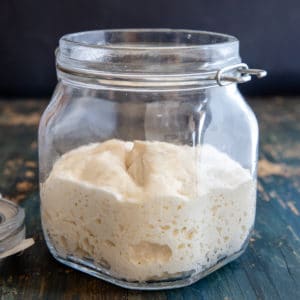
Italian Sour Dough Starter – Lievito Madre Recipe
Ingredients
STEP 1
- 105 grams all purpose or bread flour (unbleached) (¾ cup + 1 tablespoon)
- 50 grams water lukewarm chlorine free water (85F/40C) (3⅓ tablespoons)
- 1/2 teaspoon honey
STEP 2 -11
- 105 grams all purpose or bread flour (unbleached)
- 50 grams water lukewarm chlorine free water (85F/40C)
Instructions
STEP 1
- In a small bowl mix together the lukewarm water and honey, then add the flour and make a non sticky dough ball. Mark with a cross. Then place in a large glass jar, place lid on top but do not close. Let sit in a warm draft free area for 48 hours.
STEP 2
- Remove 100 grams of the dough, it's best to remove the top dry part of the dough, then keep 100 grams of the remaining dough (discard anything over the 100 grams), place in a bowl and add the flour and water, knead to form a compact dough, make a cross. Place in the jar (which has been cleaned, rinsed well and dried). Cover lightly and let rest again for 48 hours.
STEP 3
- Again remove 100 grams of the dough, it's best to remove the top dry part of the dough, then keep 100 grams of the remaining dough (discard anything over the 100 grams) place in a bowl and add the flour and water, knead to form a compact dough, make a cross. Place in the jar (which has been cleaned, rinsed well and dried). Cover lightly and let rest again for 48 hours.
STEP 4
- Again remove 100 grams of the dough, it's best to remove the top dry part of the dough, then keep 100 grams of the remaining dough (discard anything over the 100 grams), place in a bowl and add the flour and water, knead to form a compact dough, make a cross. Place in the jar (which has been cleaned, rinsed well and dried). Cover lightly and let rest again for 48 hours.
STEP 5
- Again remove 100 grams of the dough, it's best to remove the top part of the dough, then keep 100 grams of the remaining dough (discard anything over the 100 grams), place in a bowl and add the flour and water, knead to form a compact dough, make a cross. Place in the jar (which has been cleaned, rinsed well and dried). Cover lightly and let rest again for 24 hours.
STEP 6
- Again remove 100 grams of the dough, it's best to remove the top part of the dough, then keep 100 grams of the remaining dough (discard anything over the 100 grams), place in a bowl and add the flour and water, knead to form a compact dough, make a cross. Place in the jar (which has been cleaned, rinsed well and dried). Cover lightly and let rest again for 24 hours.
STEP 7
- Again remove 100 grams of the dough, it's best to remove the top part of the dough, then keep 100 grams of the remaining dough (discard anything over the 100 grams), place in a bowl and add the flour and water, knead to form a compact dough, make a cross. Place in the jar (which has been cleaned, rinsed well and dried). Cover lightly and let rest again for 24 hours.
STEP 8
- Again remove 100 grams of the dough, it's best to remove the top part of the dough, then keep 100 grams of the remaining dough (discard anything over the 100 grams), place in a bowl and add the flour and water, knead to form a compact dough, make a cross. Place in the jar (which has been cleaned, rinsed well and dried). Cover lightly and let rest again for 24 hours.
STEP 9
- Again remove 100 grams of the dough, it's best to remove the top part of the dough, then keep 100 grams of the remaining dough (discard anything over the 100 grams), place in a bowl and add the flour and water, knead to form a compact dough, make a cross. Place in the jar (which has been cleaned, rinsed well and dried). Cover lightly and let rest again for 24 hours.
STEP 10
- Again remove 100 grams of the dough, it's best to remove the top part of the dough, then keep 100 grams of the remaining dough (discard anything over the 100 grams), place in a bowl and add the flour and water, knead to form a compact dough, make a cross. Place in the jar (which has been cleaned, rinsed well and dried). Cover lightly and let rest again for 24 hours.
STEP 11
- Again remove 100 grams of the dough, it's best to remove the top part of the dough, then keep 100 grams of the remaining dough (discard anything over the 100 grams), place in a bowl and add the flour and water, knead to form a compact dough, make a cross. Place in the jar (which has been cleaned, rinsed well and dried). Cover lightly and let rest again for 24 hours.
STEP 12
- Ready to use!
Hi, how can I convert my current sour dough starter into LM? What are the necessary steps where I can jump into using my mature starter. My starter is a year old. I’m very interested in LM and am anxious to use it. Thank you for this wonderful info!
Hi Dolores, thanks so much, so to make a LM or stiff starter, take 10g of your existing starter and feed it with 50g of flour and 25g of water, you will need to knead it together instead of stirring. The next day, take 10g of the stiff starter, feed again with 50g of flour and 25g of water, again knead to combine. Repeat this for another 3-4 days. It will take time for the microorganisms to adapt. Hope that helps. Let me know how it goes. Take care!
This was my first ever attempt at LM. I love it, but have now so much, like most a kg.
I have made pizza, bread , focaccia and cookies. I just can’t discard, through out food , other than the dry part so I baked and gave starter away . Wish I could keep it longer in the refrigerator. Any suggestions , recommendations?
Thank you for your recipe .
Rosie
Hi Rosie, apparently after you feed it you can freeze it for up to a month. Or you could make recipes with it and freeze the baked goods. Glad you like it though. Take care!
With the 100 grams that are discarded 12 times , can these not be used to start another jars of LM.
I’m not clear on when the LM is ready for use and how much LM is needed to bake say a pizza.
This is my first attempt.
Thanks
Rosie
Hi Rosie, you could make another jar, but you’ll end up with so many jars. The LM is not ready to use until step 12. That is when it is ready to make bread or pizza. Everything you need to know and when to use it and what to make is actually written in the blog post. Let me know. Take care!
Thank you so much for this recipe! My sourdough is finally nice and strong. I’m going out of the country for 2 weeks. Is there anything i can do to save it since I won’t be home to feed it?
Hi JJ it should be fine in the fridge, although when you get back you may need to refresh it a 2-3 times. I have left mine for over a month and it was ok. Take care!
Thank you!!!
Hi JJ You’re welcome.
Can you use your existing starter and convert it to Lieveto Madre?
Hi Trina, yes you can, you need an active starter, this site explains everything that you need to do https://www.pantrymama.com/pasta-madre/. Hope it helps. Take care.
Hello Rosemary,
I contacted you last January asking if your Lievito Madre recipe was suitable for panattone. I did not make one then. But I now have one that I started on 31st Decrmber. It is now one month old and triples in size every day following a feed. Do you know if it is likely to be too acidic at this stage. I am not sure if I should try a bagnetto or how to do it. The only information i can find is how to do a bagnetto when LV is stored in water or wrapped in a cloth. I would very much appreciate your advice.
Rena
Hi Rena, apparently a bagnetto is done if the the LM is too acid.Throw away the outer part of the LM, the one that has been most in contact with impurities and air. With a knife, cut the LM into slices about 1cm, a little less than 1/2 inch thick. Then immerse the slices in fresh water (at a temperature of about 20C/68F) to which you add sugar or honey, useful for counteracting the acidity of the sourdough; the doses of sugar or honey must be about two grams/1/2 teaspoon for a litre/4 cups of water. Leave LM in the water and sugar for about 15-20 minutes. Do not leave it to soak for more than twenty minutes or you risk losing the specific properties of the yeast. So remember to bathe only if your mother yeast has acidity problems, it is unnecessary if the mother yeast is fine. Once twenty minutes has passed, take the mother yeast out of the water and squeeze it very delicately. The next step is to weigh it, since the quantities of flour and water to be added are then obtained from its weight.You will have to add 50 percent more flour than usual. So for example 100 grams of yeast, you have to add 150 grams of flour. The yeast, feeding on the starches of the flour, will strengthen itself and begin the leavening process. On the other hand, the water to be added in this refreshment must be calculated by eye, since you cannot know exactly the quantity of water present in the mixture after the bath and the subsequent squeezing.Let your LM rest at room temperature and then add it to your doughs.I hope this helps. But to tell the truth I have never had to do this. Let me know.
Rosemary, it’s all your fault for mentioning Cazzottini in one of your recipes that I read yesterday! Curious, I did a search and ended up on an Italian site which gives a recipe. She mentions ‘refreshed and lively sourdough’, and in one of her pictures with all the ingredients, there is a bowl with a lump (for lack of a better word) of dough with a cross cut in it. So, am I correct in thinking this type of starter is what she may be referring to? (Yes, I know asking you about another’s method and recipe, but this was all thanks to Google Translate.)
Any way, I am going to start this today and will incorporate it in my baking. Currently, I’ve dried powdered sourdough starter I re-hydrate and feed a couple days before baking with it. It’s where I like it for taste, and since I don’t use it every week, it works best this way.
By the way, I told my husband yesterday I found a new love…your site. There are so many recipes I’ve marked to add into menu planning!
Hi Mari, thanks so much, funny thing is I restarted a new Lievito Madre today because I have a few new recipes I want to make. I hope you enjoy the recipes. Take care.
Can’t wait to hear about the new recipes, Rosemary.
I do have a question about the starter. I’ve started it and it’s really actively and doing beautifully. Problem is, on Day 12 it will get the morning feed and later on we will be having to travel to another part of the country to attend my father-in-law’s funeral. I will miss DAY 13 feed and Day 14 will be later in the day.evening when we get home.
Will it be all right to miss out the day, or should I refrigerate it until we get home? At this late stage, I don’t want to muck it up.
Thanks.
Hi Marri, condolences for your father-in-law. If you can try and feed it just before you leave on the day 12. I wouldn’t refrigerate it but maybe put it in a cooler part of the house and it should be fine. Feeding it later on day 13 won’t hurt it. Let me know how it goes. Take care.
I am always baking in larger quantities of bread and in fact i am looking at a specific recipe that calls for 500g of lievito madre. How exactly do I get to that quantity and still have a sizeable quantity available for a bake the following day or two?
Thanks
Hi Mike, you will have to keep feeding the amount you have until you reach the amount that you need for the recipe. Hope that helps.
So presumably without discard at some point? Alternatively are you suggesting an additional feed in the same proportions only larger such that the following day after feeding we’d have our 500g total plus 150g remaining to keep feeding ?
Hi Mike, exactly that. Let me know how it goes.
Hi
My lievito madre is 8 Months old and strong. I used your recipe so thank you. My question is when using LM from the refrigerator. So there is the LM you need for your recipe and the LM that you put back in the refrigerator. Could you take me through the steps for example let’s say you have 200 grams of refrigerated LM ( after hard is discarded)? Let’s say I need 100 gms for the recipe. How do I refresh the LM for the recipe and How do I refresh the rest to refrigerate. Do I refresh it all together and just cut off a piece for the recipe?
Hi Steven, so if the LM has been in the fridge for less than 2 weeks – I would half the dough so I would feed the 100 let it sit, then remove 100 for the recipe the remainder I would refrigerate. Now the 100 from the halved dough, is now discard and I would probably make something with it. (eg crackers) or you could toss it. Or you could feed the whole 200, then remove the amount for the recipe and refrigerate the remaining dough. Hope that helps.
Hi Rosemary,
Thank you so much for writing such an in-depth guide to making a lievito madre. I have read through this several times, but unfortunately am still quite confused about some of the steps because this is my first time doing it.
If I make the starter and keep it in the fridge (after it’s to the point where it’s ready to use), I have to feed it every 2 weeks (at a minimum) correct? Then, when I actually want to use it, I have to “refresh it” by adding flour to the starter (1:1) and then half of water and a quarter teaspoon of honey. Since I’d be leaving this in the fridge, it says I have to repeat this process 1-2 times. But then I would be left with so much dough wouldn’t I? I guess it depends on how much of the starter I need for the recipe I’m using. Also, after refreshing, how long do you let it rise for? Are you aiming for it to double? Then, do I take some of it after I’ve refreshed it to save for future uses? Or do I take some and feed it first, and then refresh the remaining starter?
I just started it today and am excited! Thanks!
Hi Hanna, if you feed the the starter every 2 weeks and don’t use it, then you really should discard part of it or use the discard to bake something. If you do feed it every 2 weeks, then 1 feeding should be enough and yes it does depend on how much you use for the recipe. After you have fed the starter it should be left to rest/rise for 4 hours, then it will be ready to use, it should have almost doubled or even doubled. Then you take what you need from that for your recipe and the remaining is placed in the refrigerator for the next time. So for example you weigh your starter and you have 200 grams, for the recipe you need 100 grams, so I would remove 100 grams feed it with 100 grams flour and 50 grams water, form a dough, let it rise for 4 hours remove the 100 grams for my recipe and the remaining refrigerate. The 100 grams left from the beginning I could make something with it (discard recipe) or refrigerate it and keep it for the next time, although refrigerated discard will only keep for 1 week. Hope this helps, let me know.
Hello Rosemary, I am hoping to use your recipe for Lievito Madre. But I need to know that it is suitable for Panettone. Many thanks,
Rena Alexander
Hi Rena, if you plan on using a lievito madre for the pannettone then yes this is suitable.
When I print the formula, it shows step 4: 24 hours. In your main instructions, you indicate 48 hours. It may not be hugely important, but if it is, which is correct? (Thanks for all this great info.)
Hi Judy, thanks so much for letting me know, I corrected it. Have a great week.
Hello!
Sorry but how do you use it after it is ready?
Let’s say I wanna make bread with 500g of flour…. How do I know how much pasta Madre I need?
Also does it tastes the same as regular sourdough?
Thanks for the recipe!!
Hi Andrea, thanks, at the bottom of the post there are a few recipes that use lievito madre. It is the same taste as regular sourdough starter, it’s just a firm starter rather than a more liquid one. Hope that helps.
Tha ls for the reply! Somehow I was expecting a bland flavor compared to liquid starter.
I already checked some recipes! I think I’ll get started tomorrow with the mama and hope it’ll go well!
Hi Andrea, I don’t find it bland at all, I just prefer using a liquid starter, I find it easier to work with. But you might like it better. Let me know.
Question: can you use this Lievito Madre in place of a 100% hydration starter for basic sourdough breads?
Hi D, yes you can although because it is a stiffer starter you will have to add a little more water, but add 1 tablespoon at a time, so it doesn’t get too watery.
Thank you for this recipe. The one question I have is once it’s active and you refrigerate it do you continue to put in a jar covered lightly or do you seal the jar.
Hi Steven, I cover it well, so it doesn’t dry out. Have a great weekend.